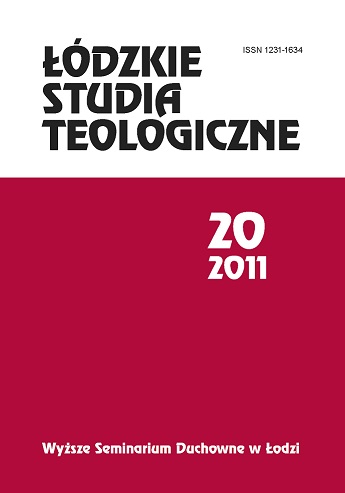Kenotyczny związek śmierci człowieka ze śmiercią Chrystusa w świetle teologii Hansa Ursa von Balthasara
A kenotic connection of man’s death with the death of Christ in the light of Hans Urs von Balthasar’s theology
Author(s): Krzysztof SzwarcSubject(s): Metaphysics, Epistemology, Existentialism, Philosophy of Religion, Ontology
Published by: Wyższe Seminarium Duchowne w Łodzi
Keywords: human kenosis; Kenoza Christ; kenoza Krzyża; death of a man; death of Christ; Balthasar Hans Urs von;
Summary/Abstract: An article tackles the issue of human death and its connection with the death of Christ in the key of the kenosis category, as proposed by Hans Urs von Balthasar, theologist of the past century. The theologian sees human existence as a donated and simultaneously as an assigned one. From the very beginning, a man’s life heads for death, as man does not exist otherwise in a mortal way. At the same time this mortal way of human existence assumes a feature of kenotic path, wherein a man follows in the footsteps of Paschal’s way of Christ. Kenotic human existence comes before man as a task in life, which makes a man similar and closer to God. Through a work of the Triune God’s salvation, limited in nature and a sinful man was gifted with eternal life. Here, the relationship marked by temporal and eternal life, where death plays a significant role both for the temporal and the eternal man. “Dying in life” and “dedication to the death” are the way of man to the eternal communion with the Triune God. Thus death is not a reality, which is only limited to biological processes, but it covers a broad perspective of human existence, being primarily called by God. Through voluntary consent to its own kenosis of life, wherein a man dies away for himself, and death of kenosis, wherein a man accepts a finite way of existence in the temporal and the inevitability of this occurrence, the man enters into a dialogue of love with God. In this way ars bene vivendi becomes ars bene moriendi. Thanks to God’s presence in the world, which is a presence of eternal divine love, pouring out beyond Him, temporality is contained in the eternity and it is guided to the eternity. In the same way, life emerges from a death through its kenotic mark. The eternal divine love of God is the meaning of human existence. An occurrence of kenosis as a movement of God’s love has changed a meaningful way of death and has caused its revaluation. Death is not the end but it is a transition, somewhat like an entrance into the community life of God, through a voluntary consent and an release of man to Divine will. All of human existence as this one of a called man, is guided to the fullness of love, which is eternal. The man being called to the eternal happiness, is guided to it through love we believe that in eternity to become a loving “watching” love. The road, which approaches that fullness is the way of kenosis. When man faces different obstacles and barriers, man takes a proper attitude towards them through the sacrifice and devotion to free himself of God both in life and in death.
Journal: Łódzkie Studia Teologiczne
- Issue Year: 20/2011
- Issue No: 1
- Page Range: 313-332
- Page Count: 20
- Language: Polish

